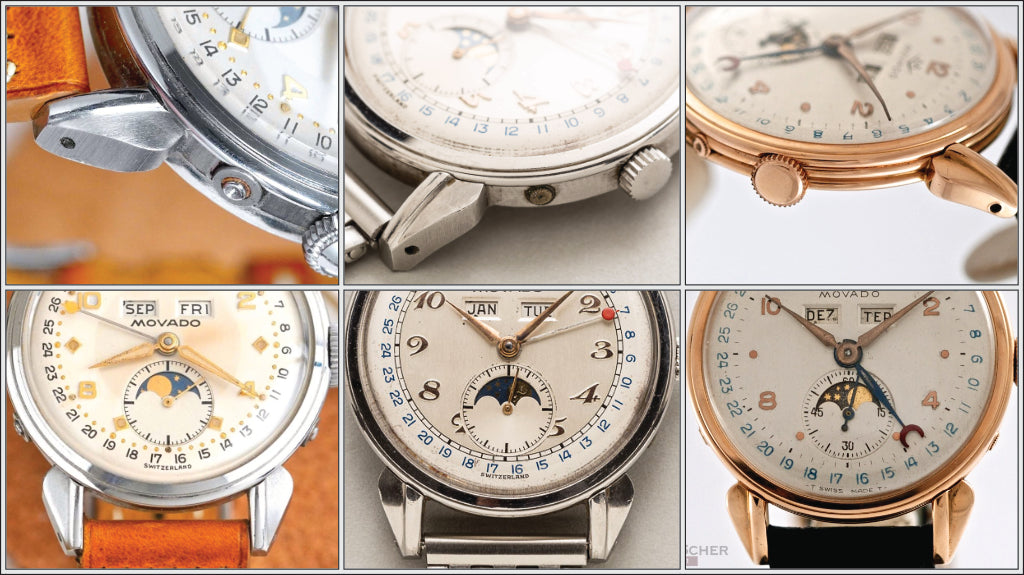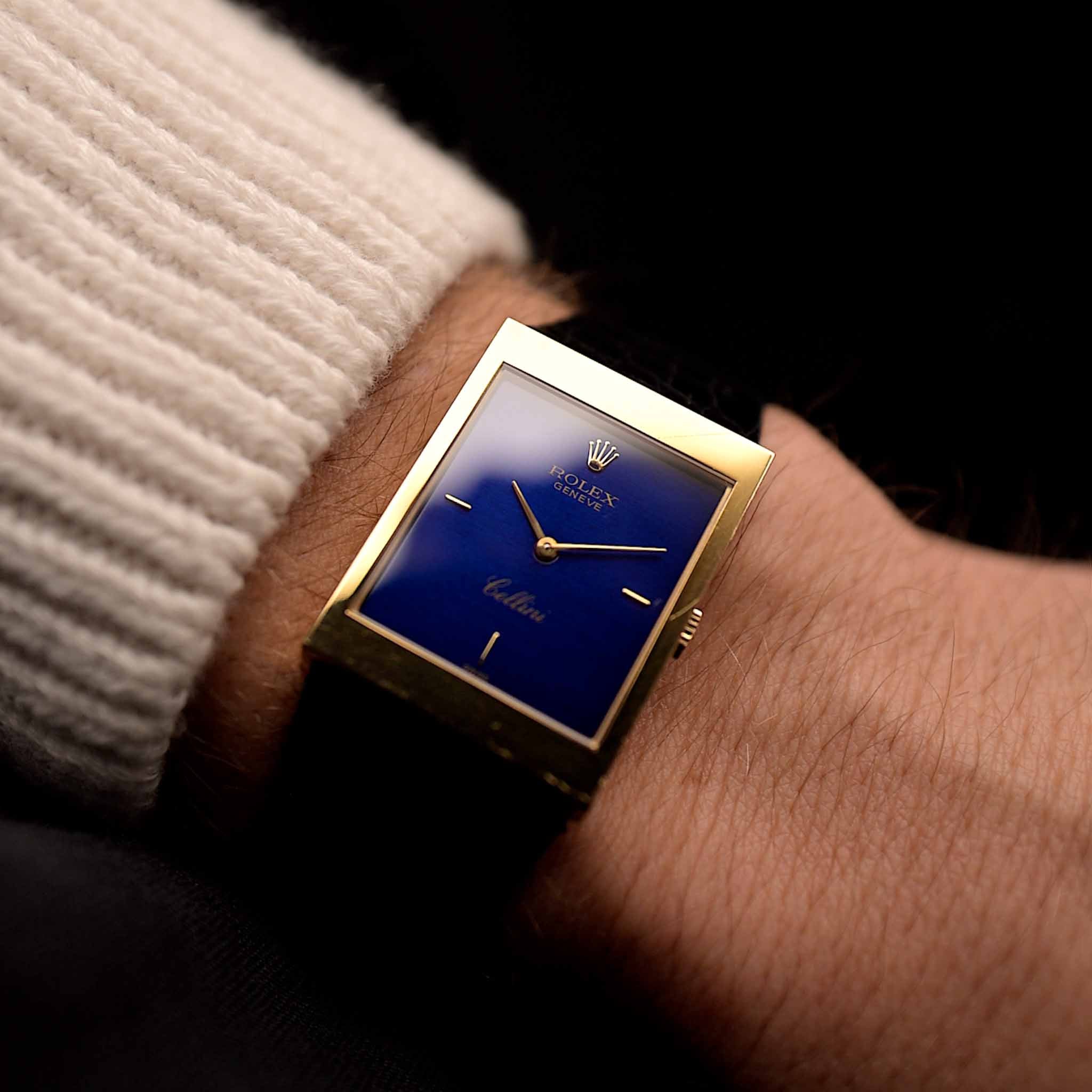It might feel like every story about UGs Polerouter has already been told... But this is not just the story of the "most waterproof" Polerouter execution but also of John Simon, the ingenious inventor and pioneer element-proofing watches during World War II.
December 04, 2024
The Polerouter Super - UGs Explorer with a 20 Year Origin Story

Marcus Siems @siemswatches
Collector, Author, Data Analyst
With the publication of "The Polerouter" by Willis and Mazzucchi in 2023 it feels almost like every story on Universal Geneve's flagship collection has been told... But this is not just the story of the "most waterproof" Polerouter executions but also of John Simon, the ingenious inventor and pioneer of waterproofing watches during World War II.
 The Polerouter Super (ref. 869112) with its beefed up case and the prominent crown is probably one of the more unusual designs of the Genta originated lineage... Photo Courtesy of Bulang & Sons.
The Polerouter Super (ref. 869112) with its beefed up case and the prominent crown is probably one of the more unusual designs of the Genta originated lineage... Photo Courtesy of Bulang & Sons.
1) The Polerouter Super
After the 'Super-Compressor' (1961, ref. 20369, [example]) and the symmetrical Polerouter 'Sub' (1964, ref. 204615, [example]) the initial 'Super' in 1965 (ref. 869112, [example]) was just the third dive-ready Polerouter and only the second with a depth rating of 300m (compare [Willis & Mazzucchi]).
In comparison to the 'classic' Polerouter the Super sported a stainless steel case on steroids. The fancy 'Lyre' were exchanged for straighter angular lugs. The crown is a brobdingnagian chunk of metal that can be screwed into the case. The movement was the next chapter in the Microtor saga, the Cal. 69. The bracelets were made by the famous Gay Freres. In terms of specs the 'Super' was second to none! It is the watch equivalent of a 1970s Arnold Schwarzenegger in a suit and tie.
And the name itself? Likely originating from the SAS DC-9-40 'Super' aircraft with altered body work to increase the passenger capacity... quite suitable if you ask me.
 A Spanish ad displaying the 'Super' as a dive watch contender. Advertorial Courtesy of UniversalGenevePolerouter.com & HighLifeWatches.
A Spanish ad displaying the 'Super' as a dive watch contender. Advertorial Courtesy of UniversalGenevePolerouter.com & HighLifeWatches.
The dive bezel (count-up) would make the 'Sub' the more fitting dive watch but the 'Super' has clearly been a designated dive watch as well (see above). Speaking of bezel... the Super came in the over ten years of its production in various dial combinations but also two references - 869112 & 869118 - the only difference being the latter coming with a golden bezel and crown.
 The gold-bezelled and -crowned 'Super' ref. 869118. Photo Courtesy of WornAndWound.
The gold-bezelled and -crowned 'Super' ref. 869118. Photo Courtesy of WornAndWound.
What made these pieces 'so waterproof' was beside the already mentioned screw-down crown is a compressor-style case: behind the case-back you can find a small metal ring that works like an elastic suspension between the movement and the case. An invention that can hold the movement in place even under conditions of increasing pressure. An invention engraved into the case-back as 'Brevet + 238872'.
2) The Opus John Simon
Taking a deep dive into the world of international patents we can find the Swiss patent CH238872 was applied in January 1944(!) by a man called John Simon. The description reads a 'Device for fixing a watch movement in a case'. If you're reading further into the patent you'll find that it is described as being used for 'waterproof' watches even though this particular patent isn't essential for water-tightening a watch. So I kept digging...
 The case-back inside of a 1966 Universal Geneve Super ref. 869112 (left) referring to the Swiss John Simon patent No. CH238872 from 1944 (right).
The case-back inside of a 1966 Universal Geneve Super ref. 869112 (left) referring to the Swiss John Simon patent No. CH238872 from 1944 (right).
What we can find out is that John Simon was an inventor based in Tramelan (close to Biel/Bienne and Bern) who registered numerous patents starting in 1938. Interestingly, all of them were - directly or indirectly - related to waterproofing a watch. His first (afaik) patent proposed a new system for a water-tight crown and winding system (compare GB524523), followed by ways to fixate movements inside watch cases (1944, GB588453), and even waterproof chronograph pushers (1943, compare GB578897)! That makes his invention come 20 years before the very first Rolex Daytona with screw-down pushers...
Ahead of his time Simon was likely driven to built the watch most suitable for the battlefields of Europe. It is somewhat surprising to only find his ideas prominently featured only two decades later. At least I couldn't find traces of his work during the 1950s and 60s. But why did it take so long?
 Around the same time that Simon was presenting his patents to the world, Universal Geneve was working on their own waterproof cases but in collaboration with Edouard Luthy from Geneva (CH243389). Watch - Universal Geneve ref. 212202 from my private collection, Advertorial Courtesy of HIFI Archiv.
Around the same time that Simon was presenting his patents to the world, Universal Geneve was working on their own waterproof cases but in collaboration with Edouard Luthy from Geneva (CH243389). Watch - Universal Geneve ref. 212202 from my private collection, Advertorial Courtesy of HIFI Archiv.
Around 1945 Universal Geneve was indeed also working on solutions for waterproof and thus dust- and element-proof watches but didn't rely on John Simon but the work of Geneva based inventor Edouard Luthy (see above, patent CH243389) and a surprisingly similar approach to Simon's that was later utilized for the Polerouter Super. But with the world returning from the horrors of war, Universal Geneve as well backed out of the dive-watch discussion.
3) Back to the Polerouter 'Super'
It is unfortunately hard to say when and how Universal Geneve got aware of the John Simon patent while again reorienting towards impermeability. After all, his name is thus engraved in the annals of horological history with some of the most coveted but also niche watches out there - The Polerouter Super but also the Polerouter 'Sub' and the 'Space Compax' (ref. 885104). All of them sharing the same Simon system and the "Brevet + 238872".
 If a Polerouter 'Super' feels doesn't feel Garfunkel-ly enough, why not going all-out 1960s space-age chrono with UGs 'Space-Compax' ref. 885104? Photo Courtesy of Hodinkee.
If a Polerouter 'Super' feels doesn't feel Garfunkel-ly enough, why not going all-out 1960s space-age chrono with UGs 'Space-Compax' ref. 885104? Photo Courtesy of Hodinkee.
The Polerouter 'Super' itself is closer to some of the most collectable Universal Geneve watches out there than you think. And here's what else I personally love about these pieces: It shares a lot of the original Genta Polerouter DNA while being visibly stronger. It's a completely different watch not just because of the crown. Holding these pieces you already can feel the substance.
Surprisingly, they aren't overly huge (35.5mm) and not even thick - some iterations just ~10mm depending on the vintage (and thus crystal). If you compare this to a 1957 Omega Railmaster or a ref. 1016 Rolex Explorer - similarly tool-heavy watches with smooth bezel - that's about 3mm or one quarter less while still adding a date-function. All because UG benefitted from their super-thin Cal. 69 Microtor.
 I can't overcome how cool this iteration is (ref. 869112/25)... slate grey dial, well executed minute, second and 1/5th second track to reminisce the original Polerouter track and the best date-window shape out there... Photo Courtesy of Hodinkee.
I can't overcome how cool this iteration is (ref. 869112/25)... slate grey dial, well executed minute, second and 1/5th second track to reminisce the original Polerouter track and the best date-window shape out there... Photo Courtesy of Hodinkee.
The Polerouter 'Super' is thus an unnecessarily cool and overlooked watch. It's UGs answer to the Explorer but with more variation, more fun and more action happening on the dial. And have you checked the finishing on these pieces? The play between brushed and mirror polished case surfaces is marvelous and I haven't even started discussing the Cal. 69.
I don't talk value often but when you compare the specs I challenge you to find another 1960s one-for-all watch that can match the 'Super' and is competitively priced.
It proves to show yet again how well ahead of the curve Universal Geneve was back in the day. The 60 year anniversary of the 'Super' collection is just around the corner and no ref. 869112 would need to shy away to compete against any new release happening in 2025.
 A study of the Universal Geneve Polerouter ref. 869112/02 with white dial. Photos Courtesy of Goldammer Archives.
A study of the Universal Geneve Polerouter ref. 869112/02 with white dial. Photos Courtesy of Goldammer Archives.
Acknowledgements
Beside the excellent "The Polerouter" book, please also check out @Hamblar's 'The Polerouter Reference Website' (also for the ref. 869112 & 869118 as well as contemporary ads).
All rights on text and graphics reserved to the Author.




























2 comments
Complimenti per la splendida prosa, una storia semplice, ricca di dettagli tecnici che appassiona anche il lettore più sapiente.
Very enjoyable and informative piece. Another Polerouter for me to chase after!
Leave a comment